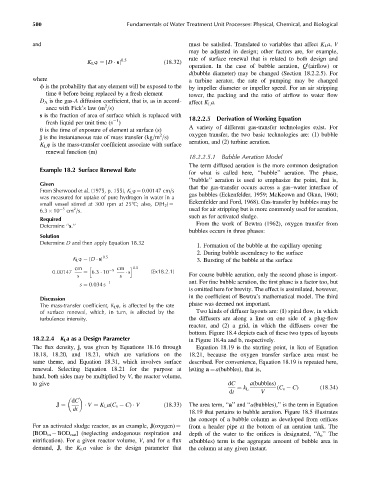Page 625 - Fundamentals of Water Treatment Unit Processes : Physical, Chemical, and Biological
P. 625
580 Fundamentals of Water Treatment Unit Processes: Physical, Chemical, and Biological
and must be satisfied. Translated to variables that affect K L a, V
may be adjusted in design; other factors are, for example,
K L w ¼ [D s] 0:5 (18:32) rate of surface renewal that is related to both design and
operation. In the case of bubble aeration, Q (airflow) or
0
d(bubble diameter) may be changed (Section 18.2.2.5). For
where a turbine aerator, the rate of pumping may be changed
f is the probability that any element will be exposed to the by impeller diameter or impeller speed. For an air stripping
time u before being replaced by a fresh element tower, the packing and the ratio of airflow to water flow
D A is the gas-A diffusion coefficient, that is, as in accord- affect K L a.
2
ance with Fick’s law (m =s)
s is the fraction of area of surface which is replaced with 18.2.2.5 Derivation of Working Equation
1
fresh liquid per unit time (s )
A variety of different gas-transfer technologies exist. For
u is the time of exposure of element at surface (s)
2
j is the instantaneous rate of mass transfer (kg=m =s) oxygen transfer, the two basic technologies are: (1) bubble
aeration, and (2) turbine aeration.
K L w is the mass-transfer coefficient associate with surface
renewal function (m)
18.2.2.5.1 Bubble Aeration Model
The term diffused aeration is the more common designation
Example 18.2 Surface Renewal Rate
for what is called here, ‘‘bubble’’ aeration. The phase,
‘‘bubble’’ aeration is used to emphasize the point, that is,
Given
From Sherwood et al. (1975, p. 155), K L w ¼ 0.00147 cm=s that the gas-transfer occurs across a gas–water interface of
was measured for uptake of pure hydrogen in water in a gas bubbles (Eckenfelder, 1959; McKeown and Okun, 1960;
Eckenfelder and Ford, 1968). Gas-transfer by bubbles may be
small vessel stirred at 300 rpm at 258C; also, D(H 2 ) ¼
2
6.3 10 5 cm =s. used for air stripping but is more commonly used for aeration,
such as for activated sludge.
Required
Determine ‘‘s.’’ From the work of Bewtra (1962), oxygen transfer from
bubbles occurs in three phases:
Solution
Determine D and then apply Equation 18.32
1. Formation of the bubble at the capillary opening
2. During bubble ascendency to the surface
K L w ¼ [D s] 0:5 3. Bursting of the bubble at the surface
cm h 5 cm i 0:5
0:00147 ¼ 6:3 10 s (Ex18:2:1)
s s For coarse bubble aeration, only the second phase is import-
s ¼ 0:034 s 1 ant. For fine bubble aeration, the first phase is a factor too, but
is omitted here for brevity. The effect is assimilated, however,
in the coefficient of Bewtra’s mathematical model. The third
Discussion
The mass-transfer coefficient, K L w, is affected by the rate phase was deemed not important.
of surface renewal, which, in turn, is affected by the Two kinds of diffuser layouts are: (1) spiral flow, in which
turbulence intensity. the diffusers are along a line on one side of a plug-flow
reactor, and (2) a grid, in which the diffusers cover the
bottom. Figure 18.4 depicts each of these two types of layouts
18.2.2.4 K L a as a Design Parameter in Figure 18.4a and b, respectively.
The flux density, j, was given by Equations 18.16 through Equation 18.19 is the starting point, in lieu of Equation
18.18, 18.20, and 18.21, which are variations on the 18.21, because the oxygen transfer surface area must be
same theme, and Equation 18.31, which involves surface described. For convenience, Equation 18.19 is repeated here,
renewal. Selecting Equation 18.21 for the purpose at letting a ¼ a(bubbles), that is,
hand, both sides may be multiplied by V, the reactor volume,
to give dC a(bubbles)
¼ k L (C s C) (18:34)
dt V
dC
V ¼ K L a(C s C) V (18:33) The area term, ‘‘a’’ and ‘‘a(bubbles),’’ is the term in Equation
dt
J ¼
18.19 that pertains to bubble aeration. Figure 18.5 illustrates
the concept of a bubble column as developed from orifices
from a header pipe at the bottom of an aeration tank. The
For an activated sludge reactor, as an example, J(oxygen) ¼
[BOD in BOD out ] (neglecting endogenous respiration and depth of the water to the orifices is designated, ‘‘h o ’’ The
nitrification). For a given reactor volume, V, and for a flux a(bubbles) term is the aggregate amount of bubble area in
demand, J, the K L a value is the design parameter that the column at any given instant.

